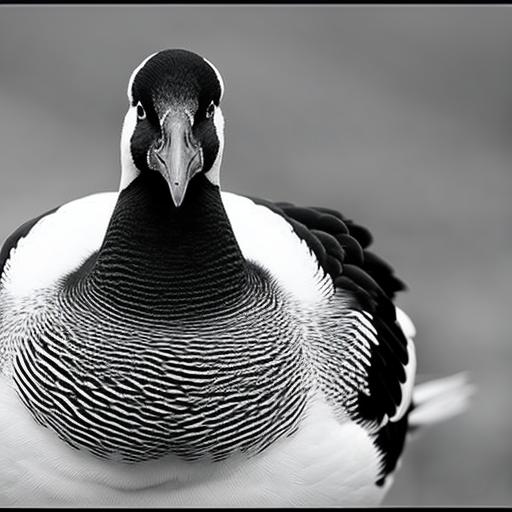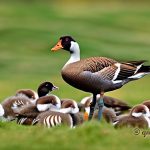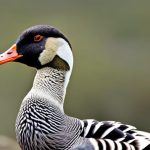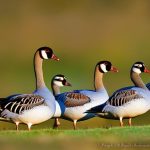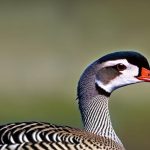Geese have been domesticated for thousands of years, with evidence of their presence dating back to ancient Egypt and China. These birds have played a crucial role in agriculture and farming, providing meat, eggs, and feathers. They are known for their hardiness, adaptability, and ability to forage for food in various environments. Geese are also valued for their ability to act as natural pest control, as they eat insects and weeds that can damage crops.
Key Takeaways
- Black and white geese breeds are popular in North America and have unique characteristics and traits.
- The main difference between black and white geese breeds is their feather color, but they also have different sizes and temperaments.
- Black geese breeds, such as the Sebastopol and African, are known for their curly feathers and strong personalities.
- White geese breeds, such as the Embden and Toulouse, are larger and more docile, making them popular for meat production.
- Raising black and white geese requires proper housing, feeding, and care, and they can be used for meat, eggs, or as pets.
Differences between Black and White Geese Breeds
Black and white geese breeds differ in their physical characteristics, behavior, and egg-laying capacity. Black geese breeds, such as the Sebastopol and African geese, have dark plumage that can range from black to gray. They are known for their long, curly feathers and elegant appearance. White geese breeds, such as the Embden and Toulouse geese, have white plumage that is often used for down production. They are larger in size compared to black geese breeds.
In terms of behavior, black geese breeds tend to be more active and vocal compared to white geese breeds. They are known for their honking calls and can be more aggressive towards intruders or predators. White geese breeds, on the other hand, are generally calmer and more docile. They are often used as ornamental birds due to their graceful appearance.
When it comes to egg-laying capacity, white geese breeds tend to lay more eggs compared to black geese breeds. White geese can lay up to 40-60 eggs per year, while black geese may only lay around 20-30 eggs per year. However, it’s important to note that individual variations within each breed can occur.
Black Geese Breeds: Characteristics and Traits
There are several popular black geese breeds, each with its own unique traits and characteristics. The Sebastopol goose is known for its curly feathers, which give it a distinctive appearance. It is a medium-sized breed that is often kept for ornamental purposes. The African goose is another black geese breed that is larger in size and has a more aggressive temperament. It is often used as a guard animal due to its loud honking and territorial behavior.
Black geese breeds are best suited for free-range or semi-free-range environments where they have ample space to roam and forage. They are hardy birds that can adapt to various climates and are known for their ability to withstand cold temperatures. Black geese breeds are also valued for their meat, which is flavorful and rich in nutrients.
White Geese Breeds: Characteristics and Traits
White geese breeds are popular for their elegant appearance and calm temperament. The Embden goose is one of the most well-known white geese breeds, with its large size and pure white plumage. It is often used for meat production due to its fast growth rate and high meat yield. The Toulouse goose is another white geese breed that is valued for its down feathers, which are used in the production of pillows and comforters.
White geese breeds are generally docile and easy to handle, making them suitable for small farms or backyard settings. They can adapt to various climates but may require additional protection from extreme cold or heat. White geese breeds are also known for their excellent egg-laying capacity, making them a popular choice for those interested in egg production.
Popular Black and White Geese Breeds in North America
In North America, there are several popular black and white geese breeds that are commonly raised on farms or kept as pets. Some of the popular black geese breeds include the Sebastopol, African, and Pilgrim geese. The Sebastopol goose is known for its curly feathers and is often kept for ornamental purposes. The African goose is larger in size and has a more aggressive temperament, making it suitable for guarding purposes. The Pilgrim goose is a smaller breed that is known for its calm and friendly nature.
As for white geese breeds, the Embden and Toulouse geese are among the most popular choices. The Embden goose is valued for its large size and meat production, while the Toulouse goose is known for its down feathers. Both breeds are docile and easy to handle, making them suitable for small farms or backyard settings.
Raising Black and White Geese: Tips and Advice
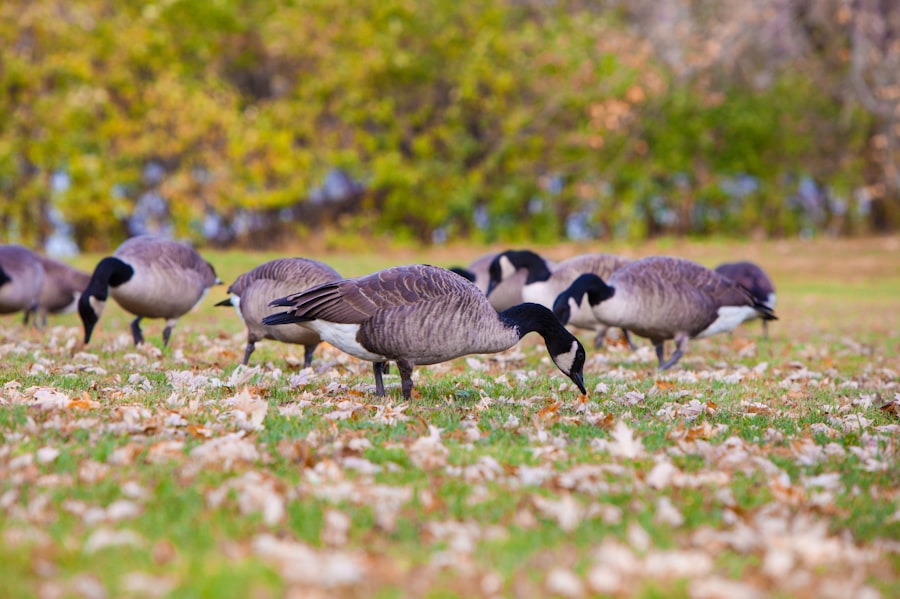
When raising black and white geese, it’s important to provide them with proper housing and feeding requirements. Geese require a secure and spacious enclosure that protects them from predators and provides them with enough space to roam and forage. They also need access to fresh water for swimming and drinking.
In terms of feeding, geese have a varied diet that includes grass, weeds, insects, and grains. It’s important to provide them with a balanced diet that includes a mix of commercial feed, fresh greens, and access to pasture or forage. It’s also important to provide them with grit or small stones to aid in digestion.
Health and wellness tips for geese include regular veterinary check-ups, vaccinations, and parasite control. Geese should also be provided with proper shelter during extreme weather conditions to protect them from heat or cold stress. Regular cleaning of their enclosure is also important to prevent the buildup of waste and bacteria.
Breeding geese requires careful planning and monitoring. Geese typically reach sexual maturity at around 2-3 years of age. They form monogamous pairs during the breeding season and will lay eggs in a nest they build on the ground. Incubation of the eggs takes around 28-35 days, depending on the breed. It’s important to provide a safe and quiet environment for the nesting geese and to monitor the eggs closely for signs of fertility and development.
Black and White Geese in Agriculture and Farming
Geese play a crucial role in agriculture and farming due to their ability to forage for food, act as natural pest control, and provide meat, eggs, and feathers. They are often used in organic farming systems as they can help control weeds and insects without the use of chemicals. Geese are also valued for their ability to convert low-quality forage into high-quality meat and eggs.
In terms of meat production, geese are known for their flavorful and nutrient-rich meat. The meat is often used in traditional dishes and is considered a delicacy in many cultures. Geese are also valued for their down feathers, which are used in the production of pillows, comforters, and other bedding products.
Raising geese can provide economic benefits to farmers, as they can be sold for meat, eggs, or as live birds. Geese are relatively low-maintenance animals that require minimal inputs compared to other livestock species. They can also be raised alongside other animals or crops, making them a versatile addition to a farm.
Conservation Efforts for Black and White Geese Breeds
Black and white geese breeds face various threats that can impact their populations. Loss of habitat, hunting, predation, and competition with invasive species are some of the main threats to these breeds. In response to these threats, conservation efforts have been put in place to protect and preserve these breeds.
Conservation organizations and breeders work together to maintain genetic diversity within black and white geese breeds. This is done through selective breeding programs that aim to preserve the unique traits and characteristics of each breed. These programs also focus on raising awareness about the importance of these breeds and promoting responsible breeding practices.
Individuals can also contribute to conservation efforts by supporting local breeders and purchasing geese from reputable sources. By doing so, they can help maintain the genetic diversity of black and white geese breeds and support the efforts of conservation organizations.
Black and White Geese in Art and Culture
Geese have been depicted in art and literature for centuries, symbolizing various meanings in different cultures. In ancient Egypt, geese were associated with the god Geb and were considered sacred animals. They were often depicted in hieroglyphs and tomb paintings.
In Chinese culture, geese are seen as symbols of fidelity and loyalty. They are often depicted in traditional paintings and are associated with the concept of family unity. In Western art, geese are often portrayed in pastoral scenes or as part of hunting scenes.
In literature, geese have been featured in various fables, stories, and poems. Hans Christian Andersen’s “The Goose Girl” is a well-known fairy tale that tells the story of a princess who is transformed into a goose. Geese are also mentioned in popular children’s books such as “Charlotte’s Web” by E.B. White.
In popular culture, geese have been referenced in movies, cartoons, and commercials. They are often portrayed as comical or mischievous characters, such as the famous Aflac duck in commercials.
Black and White Geese Breeds in the Wild: Habitat and Behavior
In the wild, black and white geese breeds can be found in various habitats, including wetlands, lakes, rivers, and grasslands. They are migratory birds that travel long distances during the breeding and wintering seasons. Geese form large flocks during migration and rely on their strong wings to cover vast distances.
Behaviorally, geese are social animals that form strong pair bonds during the breeding season. They communicate through honking calls and use body language to establish dominance or defend their territory. Geese are also known for their aggressive behavior towards intruders or predators, often hissing or flapping their wings to intimidate them.
In the wild, geese face various threats to their survival, including habitat loss, pollution, hunting, and predation. Conservation efforts aim to protect and restore their natural habitats, regulate hunting practices, and reduce the impact of pollution on their populations. By preserving their habitats and protecting them from threats, we can ensure the survival of black and white geese breeds in the wild.
If you’re interested in learning more about different breeds of geese, particularly black and white varieties, you might also find this article on Poultry Wizard fascinating. It discusses the various factors to consider when keeping turkeys and whether they need a coop. Understanding the specific needs of different poultry breeds can help ensure their health and well-being. Check out the article here: https://poultrywizard.com/keeping-turkey/do-turkeys-need-a-coop/.
FAQs
What are black and white geese breeds?
Black and white geese breeds are domesticated geese that have distinct black and white feather patterns. These breeds are commonly raised for meat, eggs, and feathers.
What are some examples of black and white geese breeds?
Some examples of black and white geese breeds include the African, Chinese, and Sebastopol geese. The African and Chinese geese have black and white feathers, while the Sebastopol geese have white feathers with black accents.
What is the size of black and white geese breeds?
Black and white geese breeds vary in size depending on the breed. African geese are the largest, weighing up to 20 pounds, while Chinese geese are smaller, weighing up to 12 pounds. Sebastopol geese are also smaller, weighing up to 10 pounds.
What is the temperament of black and white geese breeds?
Black and white geese breeds are generally docile and friendly, but can become aggressive during breeding season or when protecting their young. They are social animals and thrive in flocks.
What is the lifespan of black and white geese breeds?
Black and white geese breeds can live up to 20 years with proper care and nutrition. However, their lifespan can be shorter if they are raised for meat or if they are not given proper care.
What is the diet of black and white geese breeds?
Black and white geese breeds are omnivores and eat a variety of foods, including grass, grains, insects, and small animals. They also require access to clean water for drinking and bathing.
Meet Walter, the feathered-friend fanatic of Florida! Nestled in the sunshine state, Walter struts through life with his feathered companions, clucking his way to happiness. With a coop that’s fancier than a five-star hotel, he’s the Don Juan of the chicken world. When he’s not teaching his hens to do the cha-cha, you’ll find him in a heated debate with his prized rooster, Sir Clucks-a-Lot. Walter’s poultry passion is no yolk; he’s the sunny-side-up guy you never knew you needed in your flock of friends!

